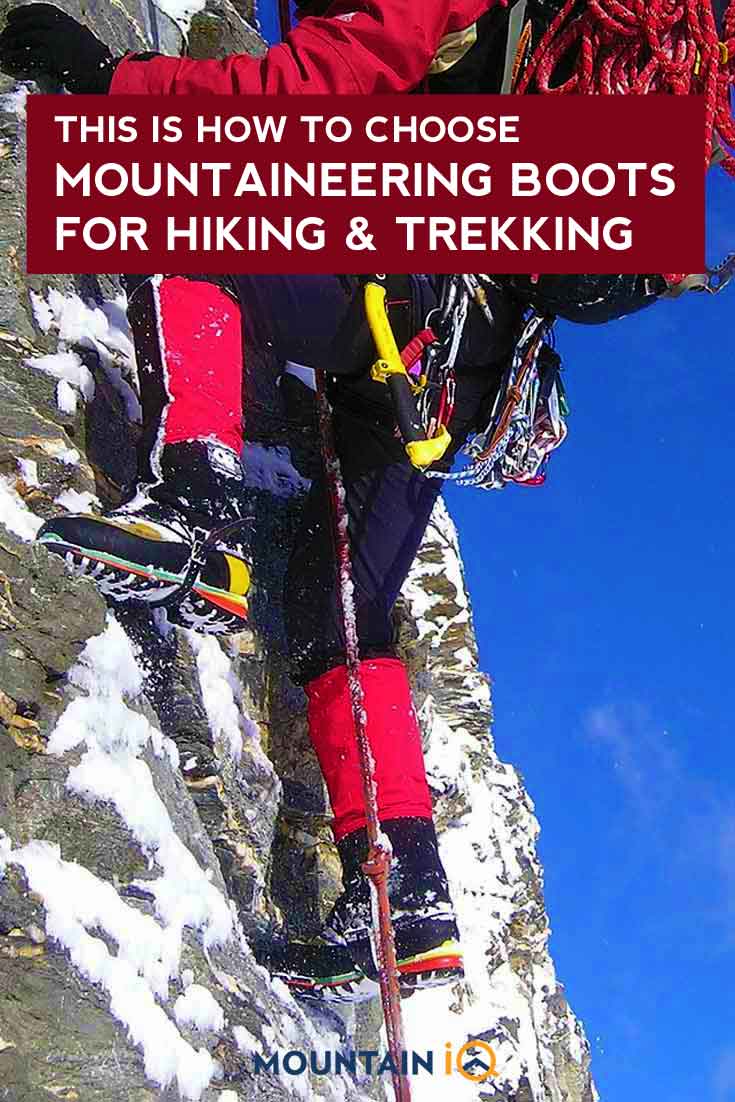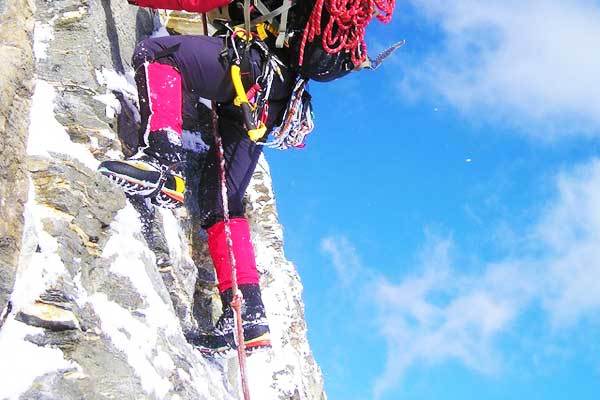Before choosing mountaineering boots and spending a small fortune on them (yes, they will all be expensive), it's worthwhile taking some time to research the best boots for your particular needs.
Do you need a boot that prioritises warmth for high altitude mountaineering? Are you going to be doing any technical ascents? How important is weight?
These questions and more will define which mountaineering boots you should go for.
Let's jump in and look at the best mountaineering boots.
Best Mountaineering Boots (Top Picks)
Best Overall
Best For Technical Tracks
Best For Women
This article contains affiliate links. If you buy something through the links on this page, we might get a small commission. It will not affect your price but helps keep our site alive!
Top Boots For Mountaineering
Here are my top mountaineering boots:
- SCARPA Grand Dru GTX Waterproof Boots - Best Overall
- Salewa Rapace GTX Mountaineering Boots - Most Comfortable
- La Sportiva Women’s Nepal Cube GTX - Best For Women
- La Sportiva Men's Spantik Boot
- Scarpa Charmoz HD Mountaineering Boots - Best For Technical Tracks
Read our complete buyers guide for mountaineering boots.
Best Overall Mountaineering Boots
1. SCARPA Grand Dru GTX Waterproof Boots
As a well-insulated, gripping mountaineering shoe, the SCARPA Grand Dru GTX Waterproof Boots is our best overall mountaineering shoe due to its well-rounded performance.
In comparison to the average mountaineering boot, these 875g shoes are some of the lightest out there.
There’s no sacrifice on warmth here either – the outsoles of the boots may be slightly thinner than most (hence the weight), but this makes more room for a thicker, warmer midsoles.
Combined with the Primaloft synthetic insulation and super-gaiters, these boots are very warm, especially for a single boot.
The gaiter is made of waterproof, breathable material with a YKK zipper, creating an impermeable layer that fully protects you from water, snow and ice. You could stand in 10 inches of water before a drop gets in.
A lace lock keeps tension in the forefoot, which makes ice climbing with crampons feel much better.
There’s also a great range of motion in the ankle and good ground sensitivity through the soles for better navigation. The rigid sole and calf support means they are relatively comfortable even without crampons.
Main Features
What we like
What we dislike
Key Takeway
The SCARPA Charmoz HD Waterproof Boot has been rated the best overall mountaineering boots due to its all-round combination of remarkable traits, making it capable of tackling steep ice, tricky mixed climbing and rocks.
2. Salewa Men's Rapace GTX Mountaineering Boot
This boot continues to impress its users with its insane combination of comfort and great efficiency in the mountains.
One of the reasons it is so comfortable is because of its superior lightness.
The Salewa Rapace GTX Mountaineering Boot weighs even less than the Phantom Tech, at 680g. The shoes also contain a Salewa Y support system, which runs steel wire along the ankles and heel, creating lightweight support and heel containment.
With the EVA midsoles, responsible for absorbing shock and cushioning the feet, these shoes perfectly balance flexibility and sturdiness.
Because of its reputable comfort, the Rapace GTX has an almost non-existent break-in period. Owners are delighted to come back from expeditions blister-free, even when using the shoes straight out of the box.
Gore-Tex waterproof membranes keep your feet dry and comfortable while letting them breathe, but users have questioned the effectiveness.
The Vibram mountaineering rubber soles, however, do make these shoes equally equipped to tread across snow and ice as well as dry surfaces.
Main Features
What we like
What we dislike
Key Takeaway
For exceeding comfort and climbing performance, look no further than the Salewa Men's Rapace GTX Mountaineering Boots; but we advise you purchase them only if you are opting for dry mountaineering, due to their questionable water protection.
3. La Sportiva Women’s Nepal Cube GTX
There are limited choices for female fits when it comes to mountaineering boots, but satisfied owners claim that these shoes solve this issue with happy feet.
The Nepal Cube GTX is the upgraded version of the very popular Nepal Evo.
The new model has greatly reduced its weight, knocking off an entire 285 grams. Other differences include some aesthetic changes and some added features.
The Vibram sole with the Impact Brake System means these shoes can tackle uphill clambers as well as steep descents.
They require practically no breaking in due to their cushioning and fit.
The removable tongue and lace system are adjustable to allow the perfect fit, with enough room for thick socks and a toe box that has space to wiggle your toes.
Some new features on the Nepal Cube GTX include insulating Carbon Tech honeycomb insoles that are stiff and light, as well as a reputably waterproof and breathable Gore-Tex membrane.
Check Price
Main Features
What we like
What we dislike
Key Takeaway
La Sportiva did a fantastic job in making a light and comfortable pair of boots suitable for ice or mixed climbing and mountaineering if you are willing to adjust to the lack of insulation.
4. La Sportiva Men's Spantik Boot
5/5 Overall Rating
The La Sportiva Men's Spantik is a double synthetic boot designed for high altitude alpine climbing and adventures, typically up to 6000m.
Although weighing 1261g, these boots are light for how warm they are.
Double boots tend to be warmer to the cost of weight, but these modern boots are synthetic and leather, making them comfortable, dexterous and far lighter than the old-school plastic double boots.
The uppers are backed with an insulating closed-cell foam and reflective aluminium facing, making an effective thermal feature.
Because these shoes are designed for high altitude, they are not waterproof, which is a downfall. However, a perk of a double boot, in this case, is that you can remove the inner liner to dry.
The rubber outsoles offer amazing traction and are compatible with step-in crampons, while the shoe’s support set-up consists of a thermoplastic urethane ankle and backstay reinforcements.
Check Price
Main Features
What we like
What we dislike
Key Takeaway
Try the La Sportiva Men's Spantik a half size larger than needed - or at least phone in to double check the measurements - as some wearers have experienced sizing issues.
5. Scarpa Charmoz HD Mountaineering Boot
The Scarpa Charmoz HD Mountaineering Boot are designed for weight-sensitive, fast-paced and technical trails, making them our pick for the best mountaineering boot for the trickier tracks.
The Vibram Mulaz rubber outsoles keep your grip on the ground with little to no slippage, with sections designed for hard braking.
A crampon insert is also located at the end of either heel and is compatible with many crampon types, namely semi-automatic versions.
The EVA foam in the soles act as awesome shock absorbers while also aiding stability alongside the dense EVA material lining the arch area of the soles.
Polyurethane in the forefoot equates to precision in your movements. In combination, these shoes can withstand extremely uneven, rough terrains with little impact on your feet.
Most of the upper and insole of these boots are made of wicking material while the rubber parts keep outside moisture from getting into them, keeping your feet dry.
Check Price
Main Features
What we like
What we dislike
Key Takeaway
Scarpa Charmoz are the light, comfortable, high-performance boots that are perfect for hardcore mountaineers. We advise you try a half size larger than needed.
Mountaineering Boots Buyer's Guide
Scrambling over rocks and through rough terrain requires stability, protection and comfort – the ratio of which depends on what trails or activities you wish to pursue.
There are many things to consider before purchasing a new pair of mountaineering boots in order to appeal to your needs, some of which we have listed below.
Sizing
Because sore, blistered feet are the last thing you want to worry about when you are halfway into a multi-day high altitude trek, size is one of the most important considerations to make when buying mountaineering boots.
When you do look into buying mountaineering boots, take note of this: it’s common to hear people complain about how their feet are feeling squished or that their toes are banging; it’s more rare to hear someone say how their boots are too big.
Ask how high you are thinking of trekking, as your feet swell in high altitudes. And if you are looking into a leather pair of boots, know that over time and exposure leather tends to shrink.
Therefore, when in doubt, always opt for one size larger.
Single vs Double
Mountaineering boots come as either a single or a double boot. A double boot has a separate inner liner and an outer shell, whereas a single boot is a one-piece boot.
Double boots are warmer but having two separate parts means more weight, and these days most single boots tend to be warm and stiff enough to excel during all four seasons. However, having a double boot means you can dry out the liners, which is suitable if your hike involves camping.
Waterproof boots can avoid getting their insides wet, but take note that a con of having waterproofed boots is that if any water or snow does leak inside of them, it is trapped there. Because of this, double boots are also advisable if you plan to cross any streams, creeks, deep snow etc.
Weight & Warmth
The less weight we carry, the easier and more efficient we can be in the mountains; the same can be said with warmth. Nobody gets very far very comfortably with frozen toes.
Proper mountaineering boots tend to be heavy, which is why it is important to consider the value of where that weight is coming from.
These values should stem from traction, protection and warmth. A lightweight pair of boots will weigh around 1.5kg, and traditionally this meant less warmth. But with recent designs and technological advances, this isn’t necessarily true.
A great new feature that offers the best of both worlds is an integrated gaiter. An integrated gaiter is designed to keep snow out of your boots and pants, adding tons of warmth to your boots while decreasing the weight of your setup.
Find a pair of boots that provide enough warmth for your intended use but that don’t weigh you down. It is important to never sacrifice a good fit for the sake of weight. Through long, treacherous treks, you will thank yourself for it.
Mountain Activity & Conditions
Identifying the weather conditions and the activities that you will use your mountaineering boots for – whether it be for sunnier hikes, ice climbing or autumn mountaineering etc. - is imperative to select the correct pair.
Each activity and climate type require different kinds of equipment; and because of this, finding one boot that will excel in a variety of uses is hard.
Someone who plans to only venture out on warmer winter days and stay below tree lines will not have to prioritize warmth in their boots, while a technical climber would focus on weight-effective boots.
Ideally, find one pair of boots that specifically suite only one of your intended activities. Because of this, a lot of avid outdoor adventurers tend to own more than one pair.
Continue browsing
See more equipment reviews and our detailed outdoor footwear guide. Or check out these reviews:







Hello, you have to talk about these Italian and Austrian boots companies producing in Asia using cheap glue that detach from sole in few years, leaving trekkers stranded bare foot risking to die of exposure. Is not a matter of quality, but they must WRITE THE DATE OF EXPIRE of the materials, it does not matter the way are used.
This is Responsability about the life of people, fed up of these fraudolents practices.
Cheers, Enrico.